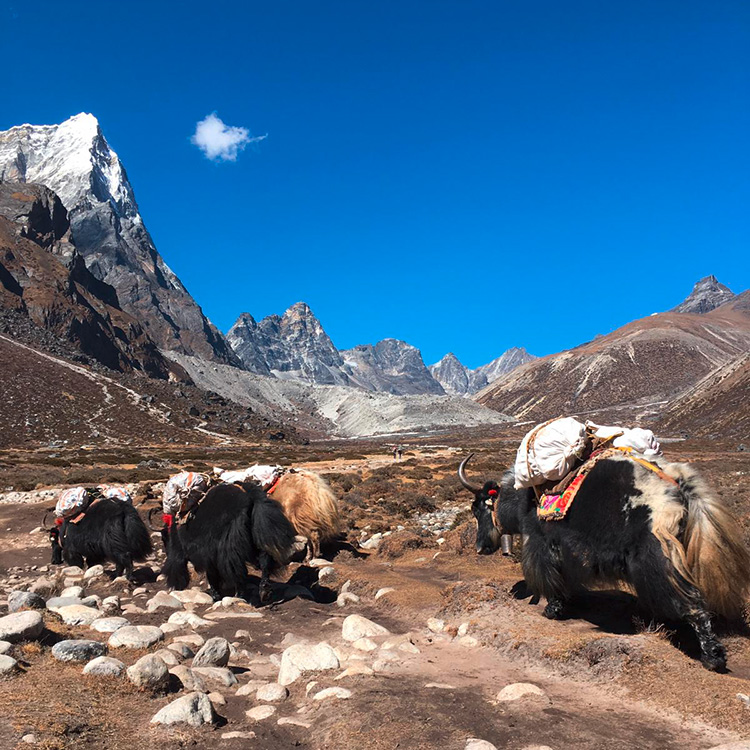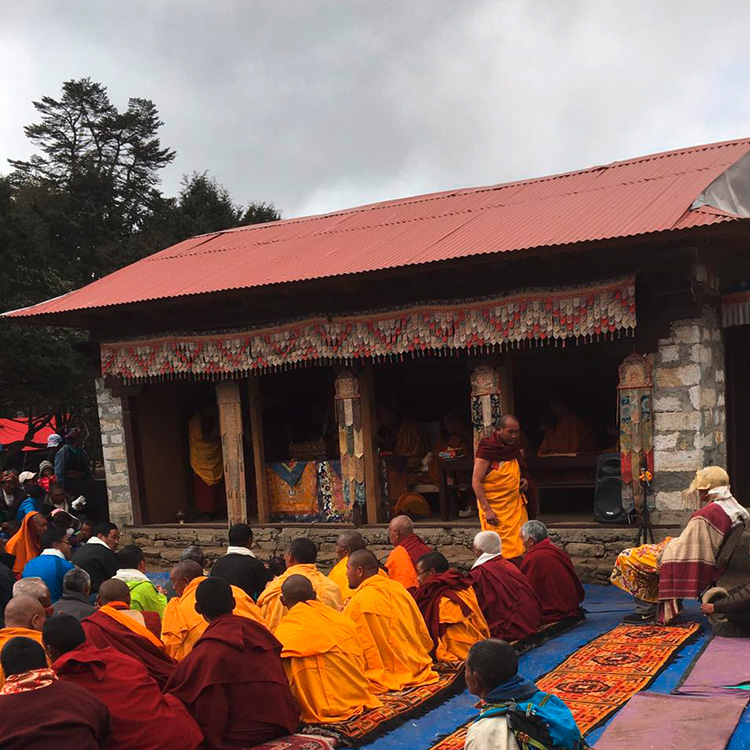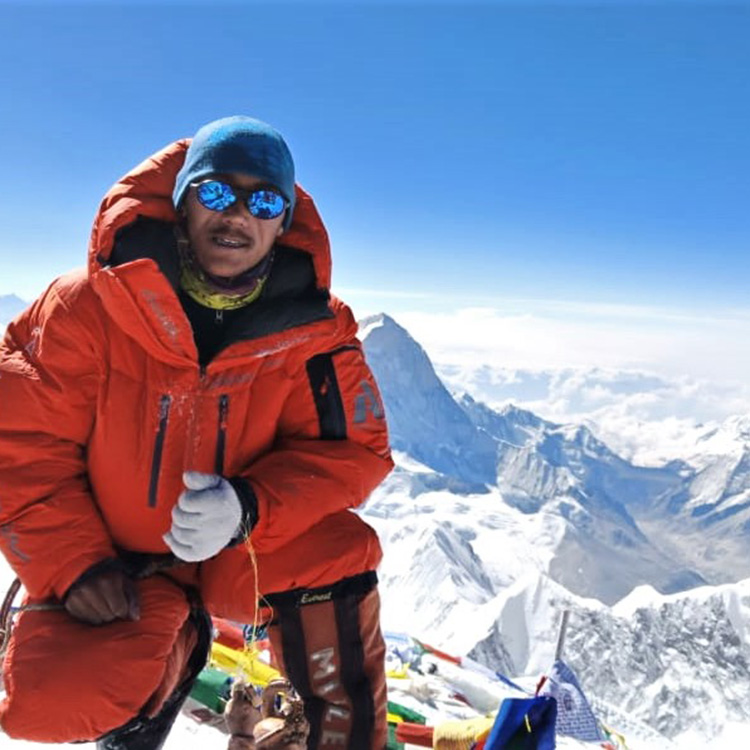Whether newcomers or experienced mountaineers, many decide to choose a professional guide for their climb to the summit. The 25-year-old Fura Sherpa, who has been working as a mountain guide for several years, points out that he has several jobs along the way: guide, cook, motivational coach, and risk manager.
Fura left his picturesque village in the Himalayas to venture on his first international trip to Europe to visit a former customer and friend who had hiked with him. flexword had the chance to welcome an exciting young man to the office and ask him more about the industry and his job as a mountaineer.
Fura lives in a remote mountain village in the Himalayas called Samde (3600m). Even though the village consists of only 17 houses, it is known in the region for welcoming Himalayan travelers and is located in close proximity to Everest Base Camp. „The rest of my family lives in the nearby villages, but the way to school or to the doctor takes a long time. This can take up to three hours,” explains Fura. Due to its remote location, purchasing also poses a challenge. The Namche market town (3440m) is only open on Friday or Saturday, so the family has to plan exactly what they need. Food is usually transported with jeeps, donkeys or yaks. When he’s asked about food prices, he describes: “Food is incredibly expensive. Instead of transporting it with animals or cars, it can also be delivered by plane. Then a pack of milk costs €6.50 instead of €1.50. Therefore, one prefers to accept a longer transport route.” In his stories it becomes clear that everyday life of the mountain dwellers is determined by the mood of nature and especially of the mountain.
When tourists arrive, their journey starts in Kathmandu at 2800m. To get to the popular Namche Bazaar, they have to take a plane from Kathmandu to Lukla. Airplanes are often not allowed to fly to Lukla Airport due to bad weather conditions. The airport is considered the most dangerous airport in the world due to its altitude and short runway. Afterwards a one-day climb is necessary to reach Namche Bazaar at an altitude of 3440m, which is a popular destination for tourists on their way to Everest Base Camp. Here you have the opportunity to experience traditional, local culture and people.
Generally, working as a mountain guide is part of the family heritage and is reserved for men, while the women take care of the house and the children when the men climb the mountain. Even though guiding is Fura‘s primary job, families can only rely on a single season of usually 3 months (May – July) to earn money and the requests are not steady. For Fura it goes without saying that in the time when he is not on an expedition he will help in the house and with his family business, which consists of four parts depending on the season and demand:
- Expedition (mountain guide, guiding agency)
- Hotel (accommodation, restaurant)
- Cattle (yaks, transport service, etc.)
- Agriculture (potatoes, vegetables, etc.)
The cultural and material gap is particularly exciting when he describes the lodges equipped for tourists at the Base Case Camp 1 in Kathmandu, which leave nothing to be desired. There are not only tents, warm meals, bathrooms and showers, but also washing machines. Among many traditional regional drinks, sweets, and food, there are also soft drinks for the tourist heart. But even Fura must admit: “Climbing a mountain and then having about a cold Coca Cola, gives you refreshment and energy.” In contrast to the comfort at Base Camp 1 with luxurious goods, at an altitude over 6.000m you need someone to boil water by gas, prepare ready-made food, and tea.
During his school days Fura already felt his passion for mountaineering, which was born in his cradle. His father, who has already been to the summit 15 times, and his brother are already enthusiastic mountaineers and made him familiar with it at an early age. “I feel guilty sometimes for choosing climbing over trekking. But I love what I do, so it was right,” admits Fura. He is one of 20 mountain guides from his village and says modestly: “I feel very small among the other mountaineers who are world record winners and have climbed the mountain several times before.”
In 2014, Fura took part in his first mountain tour, where he gained his first trekking experience as a cook helper. He remembers the incredible cold at night during the first ascent, for which he was not prepared. “During the day it is relatively warm, but the cold at night. This made it much harder to get up in the dark early in the morning and start the hike.” Working as a mountain guide since 2015, he has climbed the top with different groups every year: 2016 a Chilean group, 2017 an Indian group, 2018 he climbed twice to the top within 5 days with a fixing group for ropes, ladders but also clean-ups and afterwards with an Indian client, and in 2019 with ‘Alpenglow’.
Mountaineering with different hikes is important not only to get to know the different functions of the groups, but also to gain experience with group dynamics and communication.
Team composition is especially important, because everyone brings unique skills, expertise and experience, which are essential for group hiking. For example, it is important to have a cook who can prepare food at sub-zero temperatures or a mountain guide who can repair a rope. Regarding the question of language barriers, Fura said that it has always worked with hands and feet and everyone understands the universal gestures for „I’m cold“ or „I’m hungry“.
Climbing a mountain does not only mean physical preparation, but also requires a mental, spiritual mindset. Before tourists dare the ascent, they take part in a traditional Sherpa ceremony in a monastery. A monk blesses the mountaineers and wishes them happiness, joy and integrity without accidents during the journey. During the ascent the hikers are always accompanied and guarded by prayer flags.
Knowing how important the mountain guide service for tourists is for the region, Fura feels that Sherpas don’t get the deserved acknowledgement for their job. Before describing the challenges, he wanted to clarify a common misconception: “Did you know that “Sherpa” is not a job title?“ The name goes back to Shyar („east“) and Pa („people“), which describes the indigenous ethnic tribe of Eastern Nepal in the Himalaya”. But for many mountaineers worldwide, the term refers not only to mountain guide, but also to spiritual guide.
“When travelers arrive in Namche, they immerse themselves in our culture and get to know the hospitality of the country and people. Of course, they are also looking forward to the trip to Everest Base Camp. But they are not aware of the complications and logistical difficulties associated with equipment and supplies. Our job is to always be one step ahead. The tourists should not miss anything. Of course, we carry their luggage. When they arrive, we have already walked back and forth several times with yaks from the base camp to Namche and have prepared and organized everything – food, tents, ropes or hiking equipment. We always think of the extra equipment we wear for tourists in case something breaks or gets lost,“ explains Fura.
When asked about a trick, he mentions an important trick he learned in the beginning. “Put gloves always inside your suit. When you will put them on, they are already heat up with your body heat. Also be careful with strong wind – always attach gloves to your suit, otherwise you will see them flying away.” This is the reason why beginners and experienced mountaineers choose a mountaineering service. Very few are prepared for vital logistical challenges and prefer to focus completely on themselves and the hike. When asked about his relationship with his customers, he makes a touching statement: “You share all with the clients – the happiness, pride, worries and excitement. I basically save people, food, and oxygen. Then you will be forgotten, once they made it, which is really sad.”
The question of the group composition means a lot of experience and sensitivity. „I always ask myself, if every Sherpa fits to a customer,“ explains Fura. „This is especially important for group harmony. A typical mountaineering group consists of four Sherpas and four customers. The Sherpas always have a senior, a junior and an introductory leader. It is essential to develop a feeling for the group structure. You hike with this small group under extreme conditions and are dependent on each other – care, speed of walking and communication. The moment I realize that a customer is not well and can’t go on, we must reschedule. The clients put their lives in the hands of the leaders, who keep the group spirit alive. When delays or problems occur, customers must rely on the experience of the leader. Any deviation from the planned route and time means reorganizing stocks and equipment. Even though we as mountain guides must always maintain control, the ascent for the customers also means learning independence and courage in extreme situations. We give instruction in equipment such as ropes or climbing harnesses, which is just as important for travelers, as they learn to outgrow themselves.”
Asking constantly about their needs like food, water or oxygen is a necessity, because it has a massive effect on their energy level and strength to continue making the trip. Therefore, it is important to calculate the client’s condition and body weight to prevent health problems, such as dehydration, energy loss or dizziness. Many people are not aware of how much the lack of oxygen affects the body and consciousness. Fura has already experienced the effects of the lack of oxygen during the journey with another mountain guide. “The lack of oxygen affects your mood, energy and patience – it changes people. I have seen how a mountain guide has become increasingly aggressive towards customers, because he has felt exhausted and tired. He has constantly driven the group to hurry. As a mountain guide you have to be in control of yourself – no matter how you feel.”
The goal of every hike is of course to climb the summit. After having climbed the summit several times, Fura describes that the hardest part is not the way up, but the way down. “I saw people having a heart attack at the top and died. They are pushed and motivated by the group and themselves and when they finally make it, they are so physically and emotionally overwhelmed that they collapse. After the moment of pure bliss and excitement, they realize that they have to go all the way back and this can trigger a breakdown.”
The few minutes at the top at 8,848m means enormous stress for the mountain guide. Due to the altitude, oxygen supply per bottle is vital and every second is calculated. “Many customers are surprised and disappointed that we can only grant the group up to 5 – 10 minutes on the top. We increase the oxygen supply enormously to make this moment possible, but have to expect physical reactions like breakdowns, dizziness and tiredness from the customers and must not exhaust it.“ This is a risk for the customer himself, but also for the whole group and the descent. For him, however, the summit still means a joyful, breathtaking moment every time that one cannot get used to. Fura also happily talks about acquaintances in the Himalayas. At the top, the experienced mountain guides briefly take off their oxygen masks to recognize familiar faces and say hello.
He also addresses an important, life-sustaining rule for mountain guides and customers: “The most important rule is never to take oxygen from others or to use a foreign manufacturer you are not familiar with,” warns Fura. ”You need to know your equipment, especially the oxygen bottles and supplies. If you use a foreign bottle, you reduce the oxygen supply for a whole group, which has been meticulously calculated by the mountain guides. This can be fatal.”
Climbing a mountain is associated with enormous risks and dangers. Therefore, the question about the dangerous and frightening situations he has experienced is obvious. Fura reveals a rescue situation that he mastered during a hike. During the ascent they discovered a woman who had injured herself and could no longer walk. Since he had read a lot about rescue scenarios and watched many videos, he improvised with his team. They provisionally built a stretcher out of ropes and a mattress, which they could slide over the snow to bring them back to Base Camp. It is impressive how matter-of-factly Fura describes the situation and how important it is to function in such situations. In this context, he mentions a friend of his who is jokingly called ‘Himalayan taxi‘, because he is extraordinarily strong and a reliable carrier and rescuer in need.
Despite the routine in mountaineering, you still move in uncontrolled nature. Confrontation with death is also part of the everyday life of a mountain guide. He has seen many dead along the way. The situation was particularly extreme when a deceased mountaineer hung on a rope on the ice walls and the group had to pass him directly on the ladder. Fura and his father also witnessed the catastrophic avalanche in the Khumbu Ice Falls on April 18, 2014, where 18 Sherpa died. After this accident, many mountain guides stopped their hikes in memory of the dead. Having climbed the summit several times, he has never lost respect for Mother Nature. It is important for tourists to understand that hikers are safer with mountain guides, because they know the area and are familiar with the dangers and risks. But a mountain guide cannot guarantee survival, since they are still in a dangerous, unpredictable environment.
Technology is an important aspect that makes mountaineering easier today. One is aware of the advantages of today’s GPS technology, communication systems, fax machines, walkie-talkies, and weather forecasts, but the social component also plays an important role. This becomes particularly clear when he addresses the generation difference between mountain climbers. “When my father climbed Everest, there was no cell phone. The family is sitting at home with uncertainty and is hoping for a safe return. In addition, there were no international contacts or communication with English. Today’s communication and language communication makes everything much easier. I can send a quick message to my family at thousands of meters in altitude. It has also changed the mountaineering industry. Now you have the opportunity to stay in contact with other mountaineers and customers in the long term. Otherwise, this interview would never have been possible.”
Even if the economy and mountaineers benefit from the booming industry due to international travelers and cheap flights, the trend is causing problems. The most important economic factor is that too many permits are often given to tourists to climb the Himalayas. Climbing the mountain is not a bulk commodity, but still a spiritual path. The path of self-discovery in the loneliness of nature and the conquest of the mountain now means a package of well-being in the mountains tailored for tourists. The continuing rush of tourists even creates traffic jams on the hiking trails, which can be dangerous if important paths are blocked. But not only is traffic a problem, but also the trash and pollution in the Himalayan region. Fura also talks about the importance of the SPCC (Sagarmatha Pollution Control Committee), which regulates the waste management along the tourist routes in the Himalayan region: “During every summit we collect trash in bags and give it on the way down to a Chinese group for money. It’s important that we keep the track clean.” Anyone who is planning a trip to the Himalayas, should contact a local mountain guide who is familiar with not only the safest, but also the most ecological route, so that the breathtaking nature is preserved.
Fura never loses fascination with his home country and mountain region. When not climbing, he loves to go to a friend’s shop to rent a bike and explore the area. He hopes that the mountain guide services will be more recognized and valued. “We invite tourists to our home and culture. We give them a home to relax. Working as a mountain guide is not just a job, it is a calling. We not only go the physical, but also the spiritual way. Especially with today’s technology, it would be nice to keep in touch and receive people again or their friends. It is also an advantage to choose a mountain guide based on recommendations, as others have already experienced him in extreme situations. We appreciate feedback from customers, who become friends on the way. We are a team. We are sad and happy together. It would be nice if people would remember me after the trip.”
If you are planning a trip to the beautiful mountain region and are looking for reliable mountain guides, write a message to Fura’s email address fntsheringsherpa@gmail.com or contact him directly via his phone number +977 981-3098730.


